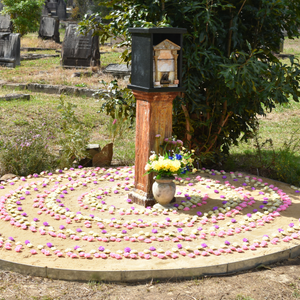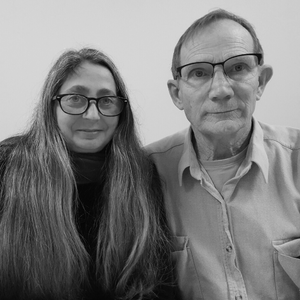Ambrosial Epitaph (2021)
Tetragonula carbonaria (native stingless sugarbag bees) hive and colony, pine wood, cast plaster, stone and flowering plants

Bees have a mythic connection with the afterlife. The role of a cemetery is healing and, beyond this, a cemetery embodies history and landscape; incorporating a whole which manifests as a unique ecosystem. Ambrosial Epitaph, is a colony of stingless Australian Native Bees, living in and working from a hive mausoleum. Ambrosial Epitaph communes with the environment; a living sculpture within the specific entity of the Rookwood biota. The visual layout and hive design becomes part of the landscape whilst the bees' industry and virtue is carried in the vitality of a resident Tetragonula carbonaria colony.
About the Artist

Mahalya Middlemist lives on Gundungurra and Dharug Country in Katoomba. Mahalya has been a practicing professional artist and filmmaker for over thirty years, producing a range of object, screen-based and installed works and has exhibited extensively both in Australia and internationally. Her current research explores the connections between memory, biography and loss.
Laurence Hall lives on Gadigal Wangal Country in Sydney’s Inner West. His public artworks utilise a range of media including interactive works, sculpture, film, video, audio, performance, pyrotechnics, water and light-shows. He has exhibited in Sculpture by the Sea and created public artworks for South Sydney Council, Centennial Park and Marrickville Council.
Transcription
I'm Laurence Hall and the person to my right is Mahalya Middlemist and our artwork is called Ambrosial Epitaph and the work itself is centered on a native beehive in a micro environment which we hope will provide space for the bees to be active and therefore a dynamic center to the installation.
The Hive, it's housed in a mausoleum, a miniature mausoleum, the goal being to resonate with the fact that Rookwood is an Acropolis and the micro environment we're creating also is a reflection of the fact that Rookwood is also a wonderful park land biota. We chose native bees as a result of researching the history of Rookwood and realizing the name came from the number of Rooks that lived there, crows being messengers of the Gods in mythology. Bees having a similar role in that they bees live in the spaces between worlds, in cracks and rocks, in the hollow trees, they make Ambrosia and they are considered in some mythologies to be messengers between this world and the next.
So our process, our process includes a lot of discussions around, the idea of mortality, around the role of the bees the role of the cemetery in society, because it's more than just body storage. As we've said, it's of park land and it gets a lot of different types of use. Rookwood is a place, the place, where people come to do a lot of different things apart from attending funerals or visiting graves. It's an area of reflection and yeah, and it's it's quite beautiful and it has history and yeah, as I said, the beginnings of our process was looking at the history of Rookwood.
We took a long time to make this work really we we had a lot of space in between and we were not able to work together, and so it's changed quite a lot from what we originally intended. It's a huge lot of amount of experimentation has gone into this as well. But we were conscious always that HIDDEN it's a sculpture walk and that people were not particularly that going there to stop and engage deeply with the work. So we hoped in our design to provide food for thought for people as they walk in the Rookwood Necropolis. No, we hope.
We hope that they notice the work and that the bees are active. They notice the industry going on around around the hive and we've also chosen to install small elements similar to Memento Mori to, just you know, just push the point that the ultimate point of living is dying, that death is actually inextricably a part of life. So we hope people get to think about that kind of positive way as they move from our work to the next work on the walk.